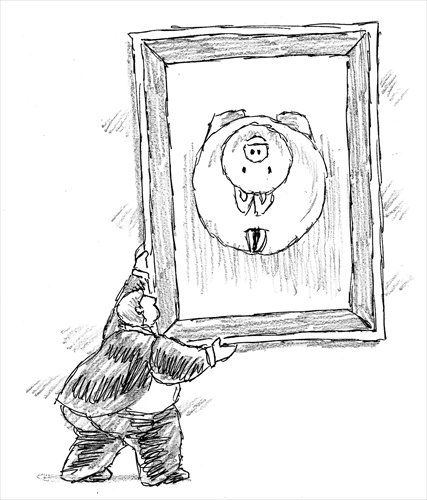HOME >> BUSINESS, OP-ED
Doubts over China’s growth data misguided
By Cao Heping Source:Global Times Published: 2015-10-26 23:23:01
Critics fail to take key factors like services strength into account

Illustration: Peter C. Espina/GT
China's GDP growth for the third quarter was 6.9 percent, slightly higher than the forecast of 6.8 percent from many financial institutions.The figure was also higher than the subjective estimates of managers in the logistics and export sectors in five coastal provinces and three municipalities (excluding Chongqing). The question has arisen again: Is China's economic growth data being inflated?
This reminds me of the year 2000, in the aftermath of the Asian financial crisis, when the growth rates of many Asian economies were cut by half or even worse. In that period, China's economic growth remained remarkably stable. From 1997 to 2000, China's economic growth rates were 8.8 percent, 7.8 percent, 7.1 percent and 8.0 percent, respectively. This growth record appeared to be impossible.
Among the doubters was Gordon Chang, who subsequently published a book titled The Coming Collapse of China, which became a New York Times bestseller. He claimed that the Chinese economy would collapse within five years. The nation underwent a stressful time.
What was worse, Chang's opinion was backed up by evidence from serious economic studies. In 2001, Thomas Rawski, a renowned economist, published an article titled What's Happening to China's GDP Statistics? After examining the statistics, Rawski found that from 1997 to 2000, China's GDP grew by 24.7 percent, but energy consumption only increased 12.8 percent.
That seemed impossible for any country. Later, some senior Indian officials claimed that China's real GDP growth might have been 5.9 percent or less. China's high-speed growth in the ensuing decade proved Rawski was wrong. As Rawski later said, he made a methodological mistake: What if China's economy was on the edge of a structural break?
To be more precise, the period from 1996 to 2003 was when the economy was experiencing a high-speed structural break, shifting from mainly investment-led growth to a combination of export-oriented and investment-led growth.
Another structural break developed circa 2015. The economy, which was long driven by investment and exports, has been shifting from a super-high gear of between 8.5 percent and 11.5 percent to a lower gear of 5.5 percent to 8.5 percent, as a result of the diminishing "demographic dividend," adverse global conditions and China's downward revision to its macroeconomic growth targets.
Two of the three drivers of China's economic growth - investment and exports - have slowed down. Along with the cooling growth has come skepticism over the true situation in China's job market. How could China have achieved the full-year target of job creation for last year in the first 10 months, and this year in only the first nine months, while seeing a decline in energy consumption on an absolute basis and particularly as the economy risks failing to fulfill this year's growth target of about 7 percent?
I fear that the methodological trap Rawski fell into could serve as an alert to us.
First, given that the economy is undergoing a structural break, the inflexibility of traditional indicators means some measurements that should have been eliminated have remained in the statistics. For example, technological improvements in energy conservation and emissions reduction are very likely to lower electricity use. Similar arguments can be made about cargo movements and outstanding credit. If we take the declines in these three categories as signs of a deterioration in the economy, then we might frighten ourselves rather than embrace the changes.
Second, it is very likely some new parameters that should have been included in the GDP statistics have been excluded. For instance, even as the growth rates for investment, exports, logistics and energy consumption have fallen, the sentiment captured in services-sector purchasing managers' indexes has stayed positive for a long time. That means new employment has shifted to the services sector.
Due to the high elasticity of employment in the services sector, the number of jobs generated by each unit of new economic output in the services sector is far higher than that in clunky workshops and heavy machinery. Job increases in the former sector and job decreases in the latter signify that the economic structure is shifting toward innovation-driven sources.
More evidence of the shift is shown by rising rates of entrepreneurship among the public and "demand pull," which is indicated by the rapid growth of the services sector.
On what grounds, then, do some people unthinkingly jump to the conclusion that there has been statistical fraud?
In an era of change, critical thinking is urgently needed. When the economy seems to encounter problems, it is lazy thinking to simply seek reasons from non-economic factors like social and moral ones, which should be strongly avoided during the period of transformation.
During China's transition to the "new normal," the move to a new growth model is successfully occurring.
In terms of the national accounts, besides the composition of traditional growth indicators, we should also include indicators of structural changes and those that measure technological advancements. Only through the methodological adjustment, can we cross-examine the possibility of statistics fraud while taking structural changes in the economy into consideration.
The author is a professor at the School of Economics, Peking University. bizopinion@globaltimes.com.cn
Read more in Special Coverage:

Posted in: Expert assessment, Biz Comments